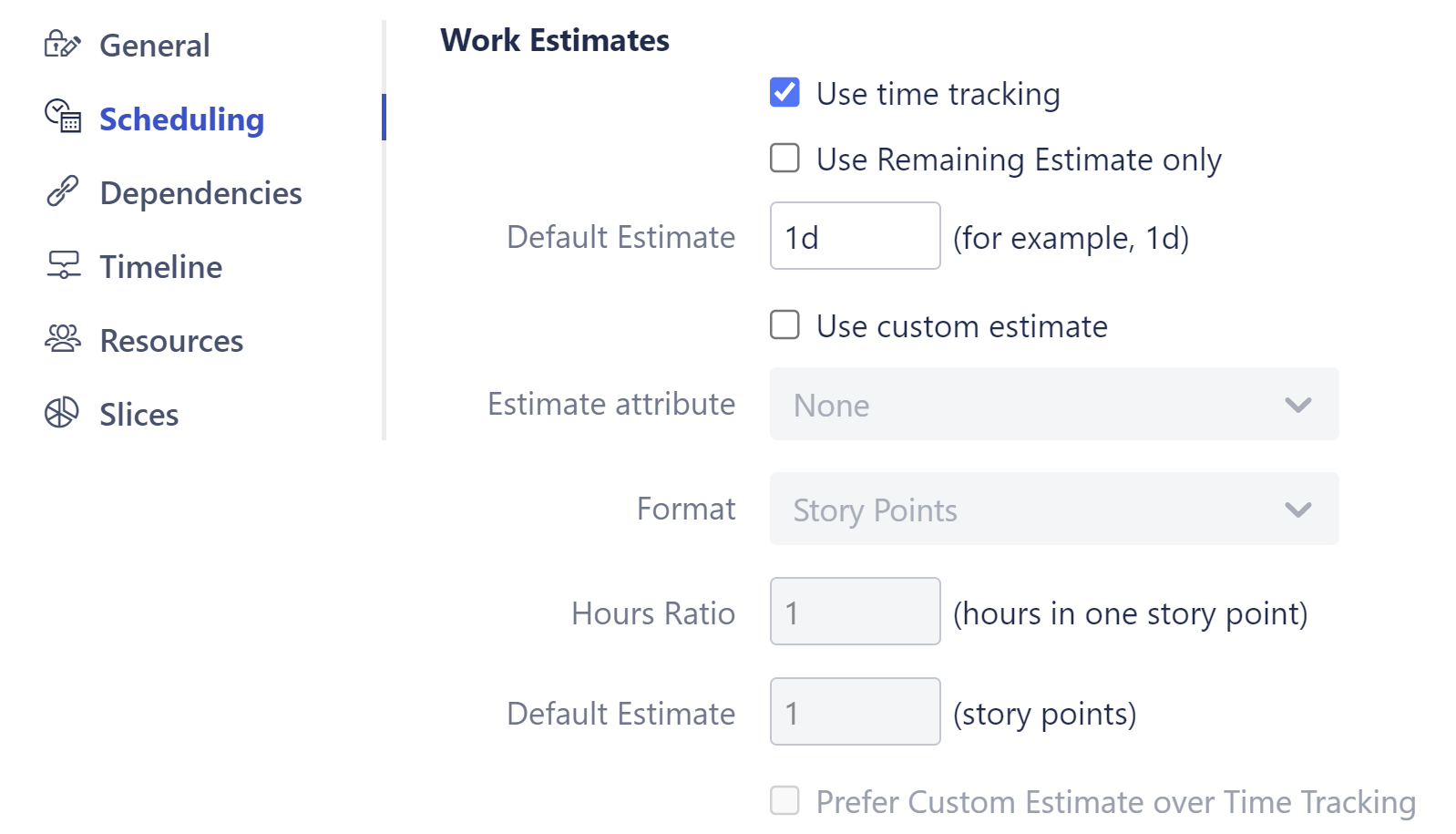Work Estimates Configuration
In this section, you can configure how the work (effort required to complete the task) is determined.

Work estimates define the amount of work (or effort) required to complete a task. The exact duration of the task will depend on the amount of work, the resource assigned to the task and the calendar. Please see the Resources section for more details.
Using Time Tracking for Work Estimate
If Use time tracking is selected, work is estimated based on:
- Time Spent + Remaining Estimate, if work has been logged for the task.
- Original Estimate, if no work has been logged.
Structure.Gantt will use this work estimate to determine the task's duration. If you adjust the task duration by changing the size of the task bar in the chart or editing the Work value in the Task Details Panel, these fields are updated accordingly:
- Remaining Estimate will be updated, if work has been logged
- Original Estimate and Remaining Estimate will be updated, if no work has been logged
Changing the size of a task bar does not affect the work estimate for fixed-duration tasks. Additionally, it is not possible to change the size of a task bar for tasks scheduled by sprints.
Use Remaining Estimate only
If the Use Remaining Estimate only option is selected, Structure.Gantt will base its work estimate only on the remaining work.
Default Estimate
The Default Estimate value is used when no other work estimate values are available for a task.
Using a Custom Estimate
If your organization uses another method to estimate work (such as Story Points), select the Use custom estimate option and select the appropriate Estimate Attribute where those values are stored.
Structure.Gantt will use the values in this field to determine the work required for each task. If you adjust the task duration by changing the size of the task bar in the chart or editing the Work value in the Task Details Panel, Structure.Gantt will update the value in this field.
Format
Select the format of the custom estimate (Story Points, minutes, hours, etc.). This allows Structure to correctly interpret the provided values.
Hours Ratio
If your custom estimate is in Story Points, select how many hours it should take to complete each Story Point. This is used to convert Story Points into hours and back, so tasks can be properly visualized on the timeline.
Default Estimate
The Default Estimate value is used when there is no value available for an issue, or the value is invalid.
Using Time Tracking AND Custom Estimate
If you are working on a project where teams use both time tracking and a custom estimate (or you're in the process of migrating from one to the other), you can select both options.
When both are selected:
- Structure.Gantt will first try to use time tracking values to determine the work estimate
- If there is no time tracking information available for an issue, it will use the custom estimate instead
- If neither are available, the Default Estimate will be used.
You can also switch this order, so that the custom estimate is used before time tracking, by checking the Prefer Custom Estimate over Time Tracking box.
Updating Work Estimates When Using Time Tracking and Custom Estimate
If you adjust the task duration by changing the size of the task bar in the chart or editing the Work value in the Task Details Panel, Structure.Gantt will update the value of the preferred estimate only:
- Time Tracking values will be updated, if Prefer Custom Estimate over Time Tracking is unchecked
- Custom Estimate values will be updated, if Prefer Custom Estimate over Time Tracking is checked
If you remove the Work value from the Task Details Panel, both the Time Tracking and Custom Estimate values will be removed, and the Default Estimate will be used.